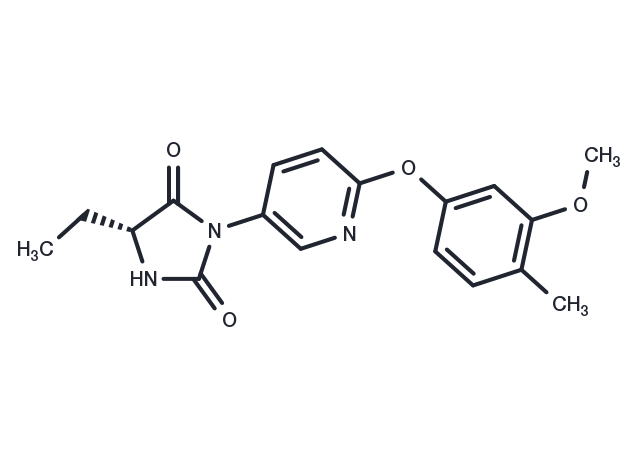Powder: -20°C for 3 years | In solvent: -80°C for 1 year


AUT1 (AUT-1) is a novel specific modulator of Kv3 channels (EC50: 4.7 and 4.9 uM for Kv3.1b and Kv3.2a).

| Pack Size | Availability | Price/USD | Quantity |
|---|---|---|---|
| 1 mg | In stock | $ 41.00 | |
| 5 mg | In stock | $ 97.00 | |
| 10 mg | In stock | $ 143.00 | |
| 25 mg | In stock | $ 253.00 | |
| 50 mg | In stock | $ 413.00 | |
| 100 mg | In stock | $ 618.00 | |
| 1 mL * 10 mM (in DMSO) | In stock | $ 97.00 |


| Description | AUT1 (AUT-1) is a novel specific modulator of Kv3 channels (EC50: 4.7 and 4.9 uM for Kv3.1b and Kv3.2a). |
| Targets&IC50 | Kv3.2a:4.9 μM, Kv3.1b:4.7 μM |
| In vitro | AUT1 increased the current mediated by human recombinant Kv3.1b and Kv3.2a channels. pEC50 values for AUT1 were 5.33 (4.7 μM) and 5.31 (4.9 μM) for Kv3.1b and Kv3.2a, respectively [1]. Using Chinese hamster ovary cells stably expressing rat Kv3.1 channels, lower concentrations of AUT1 shift the voltage of activation of Kv3.1 currents toward negative potentials, increasing currents evoked by depolarization from typical neuronal resting potentials [2]. |
| Cell Research | The population patch-clamp mode of an automated voltage clamp recording with IonWorks Quattro was used. Briefly, the effects on these channels were tested using 384-well population patch-clamp plates. Seal resistance was measured for each well, and cells were perforated by incubation with 100 mg/ml amphotericin B. Cells were held at 270 mV and stepped to 215 mV for 100 milliseconds (partial channel activation), and after 100 milliseconds at 270 mV, a second pulse to 140 mV was applied for 50 milliseconds (full channel activation). In all of the experiments, this voltage protocol was applied to cells before and following a 3-minute incubation with AUT1. 1-Cyclohexyl-1-[(7,8-dimethyl-2-oxo-1H-quinolin-3-yl)methyl]-3-phenylurea (10 mM), which we had previously found to be a potent and full activator of human Kv3.1 and Kv3.2 channels, was included in all assays as a standard. An external buffer with the addition of dimethyl sulfoxide (DMSO) was also tested to provide a vehicle baseline. Recordings were performed in the following buffers: Dulbecco's phosphate-buffered saline (PBS) with MgCl2 and CaCl2 as an extracellular solution and 50 mM KCl, 100 mM K-gluconate, 3.2 mM MgCl2, and 5 mM HEPES, pH 7.3 adjusted with KOH, as an intracellular solution. An online correction of 115–20 mV was applied to correct for junction potentials. The current signal was sampled at 10 kHz [1]. |
| Molecular Weight | 341.36 |
| Formula | C18H19N3O4 |
| CAS No. | 1311136-84-1 |
Powder: -20°C for 3 years | In solvent: -80°C for 1 year
DMSO: 250 mg/mL (732.36 mM)
You can also refer to dose conversion for different animals. More
bottom
Please see Inhibitor Handling Instructions for more frequently ask questions. Topics include: how to prepare stock solutions, how to store products, and cautions on cell-based assays & animal experiments, etc.
AUT1 1311136-84-1 Membrane transporter/Ion channel Potassium Channel Kv3.1b corticolimbic circuits inhibit dysfunction recombinant human Kv3 channels human recombinant KcsA schizophrenia AUT 1 AUT-1 Inhibitor Kv3.2a inhibitor
